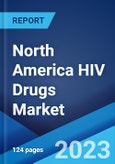HIV, which stands for human immunodeficiency virus, is a type of retrovirus which damages the immune system by destroying the white blood cells, or CD4 cells, that help in fighting against infection. Antiretroviral therapy, or ART, is known as the method used for treating the HIV infection with HIV drugs. ART patients must follow the HIV regimen every day in which they have to consume a prescribed combination of HIV drugs. This therapy method does not cure HIV but, instead, helps people with the infection to lead longer and healthier lives. HIV drugs help in preventing the multiplication of HIV which provides a possible recovery chance to the patients. These drugs make the immune system strong enough to resist certain infections and other HIV-related complications.
North America HIV drugs market is currently being driven by several factors. The region currently represents one of the strongest economies leading to a well-established healthcare system. This acts as one of the key factors which is fostering the growth of the HIV drugs market in the region. In addition to this, the US and Canadian governments are consistently extending their helping-hand by investing funds on the research and development of safer and potent HIV drugs. Moreover, higher diagnosis and treatment rate coupled with a surge in the adoption of advanced treatments act as another factor which is facilitating the growth of the HIV drugs market in North America. Apart from this, Antiretroviral drugs have played a major role in improving survival rates and the quality of life of HIV patients. These drugs help the immune system to keep the levels of the virus to a minimum level and prevent infections, leading to the prolonged life expectancy in patients. Antiretrovirals, when taken in the right combination can result in immune reconstitution, restore health, and prevent the development of AIDS and AIDS-related conditions. The progressive reduction in mortality and gains in the life expectancy are also a result of the improvements in therapy over the past few years. Additionally, antiretroviral drugs help in reducing the risk of HIV transmission. HIV treatment helps in reducing the level of the virus in the blood and other bodily fluids such as semen and vaginal and rectal fluids to imperceptible levels. It also helps in controlling the replication of the virus in the body.
Key Market Segmentation:
The publisher provides an analysis of the key trends in each sub-segment of the North America HIV drugs market report, along with forecasts at the regional and country level from 2023-2028. The report has categorized the market based on drug class and distribution channel.Key Regions Analysed
- United States
- Canada
- Analysis for Each Country
Market by Drug Class
- Nucleoside Reverse Transcriptase Inhibitors
- Multi-Class Combination Products
- Protease Inhibitors
- HIV Integrase Strand Transfer Inhibitors
- Non-Nucleoside Reverse Transcriptase Inhibitors
- Entry Inhibitors - CCR5 Co-Receptor Antagonist
- Others
Market by Distribution Channel
- Hospital Pharmacies
- Retail Pharmacies
- Online Pharmacies
- Others
Value Chain Analysis
- Key Drivers and Challenges
- Porters Five Forces Analysis
- Competitive Landscape
- Competitive Structure
- Key Player Profiles
Key Questions Answered in This Report:
- How has the North America HIV drugs market performed so far and how will it perform in the coming years?
- What are the key regions in the North America HIV drugs market?
- What has been the impact of COVID-19 on the North America HIV drugs market?
- What is the breakup of the North America HIV drugs market on the basis of drug class?
- What is the breakup of the North America HIV drugs market on the basis of distribution channel?
- What are the various stages in the value chain of the North America HIV drugs industry?
- What are the key driving factors and challenges in the North America HIV drugs industry?
- What is the structure of the North America HIV drugs industry and who are the key players?
- What is the degree of competition in the North America HIV drugs industry?
- What are the profit margins in the North America HIV drugs industry?
Table of Contents
Methodology

LOADING...
Table Information
| Report Attribute | Details |
|---|---|
| No. of Pages | 124 |
| Published | September 2023 |
| Forecast Period | 2022 - 2028 |
| Estimated Market Value ( USD | $ 21.5 Billion |
| Forecasted Market Value ( USD | $ 30 Billion |
| Compound Annual Growth Rate | 5.7% |
| Regions Covered | North America |









